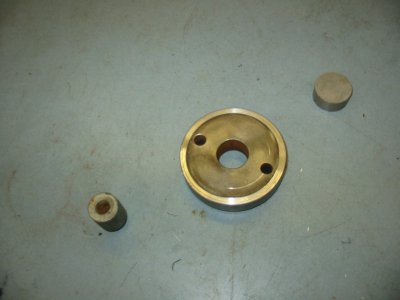R
rustydog
Forum Guest
Register Today
I need to produce 6 specialized v-belt pulleys for a pilot project. Being as overly thrifty as I am, I'm going to use 6 disks of free machining steel from the scrap box. The problem is that the hole in the center of the scrap box disk 1" and I need 5/8". The 2 smaller holes near the rim of the disk are not a problem and will be left as they are. The picture shows the disk and both a solid plug example and a pre-drilled plug example.
The plan is to turn plugs to fit into the 1" hole and weld them into place. The 5/8" hold will then be drilled through the plug piece. I'll chamfer both sides of both the plug and the scrap box disk before welding and then finish the plug / disk pair level after welding.
Questions
1) Should the plug be a tight or loose fit to minimize resulting stress.
2) Should I use a solid plug or a plug with a pre-drilled hole to reduce stress?
3) Are there other considerations I need to deal with?
4) All thoughts and critique welcome.

The plan is to turn plugs to fit into the 1" hole and weld them into place. The 5/8" hold will then be drilled through the plug piece. I'll chamfer both sides of both the plug and the scrap box disk before welding and then finish the plug / disk pair level after welding.
Questions
1) Should the plug be a tight or loose fit to minimize resulting stress.
2) Should I use a solid plug or a plug with a pre-drilled hole to reduce stress?
3) Are there other considerations I need to deal with?
4) All thoughts and critique welcome.


